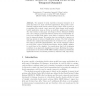Free Online Productivity Tools
i2Speak
i2Symbol
i2OCR
iTex2Img
iWeb2Print
iWeb2Shot
i2Type
iPdf2Split
iPdf2Merge
i2Bopomofo
i2Arabic
i2Style
i2Image
i2PDF
iLatex2Rtf
Sci2ools
127
click to vote
ICCV
2007
IEEE
2007
IEEE
Combined Support Vector Machines and Hidden Markov Models for Modeling Facial Action Temporal Dynamics
The analysis of facial expression temporal dynamics is of great importance for many real-world applications. Being able to automatically analyse facial muscle actions (Action Units, AUs) in terms of recognising their neutral, onset, apex and offset phases would greatly benefit application areas as diverse as medicine, gaming and security. The base system in this paper uses Support Vector Machines (SVMs) and a set of simple geometrical features derived from automatically detected and tracked facial feature point data to segment a facial action into its temporal phases. We propose here two methods to improve on this base system in terms of classification accuracy. The first technique describes the original time-independent set of features over a period of time using polynomial parametrisation. The second technique replaces the SVM with a hybrid SVM/Hidden Markov Model (HMM) classifier to model time in the classifier. Our results show that both techniques contribute to an improved c...
Related Content
| Added | 19 Oct 2010 |
| Updated | 19 Oct 2010 |
| Type | Conference |
| Year | 2007 |
| Where | ICCV |
| Authors | Michel François Valstar, Maja Pantic |
Comments (0)

